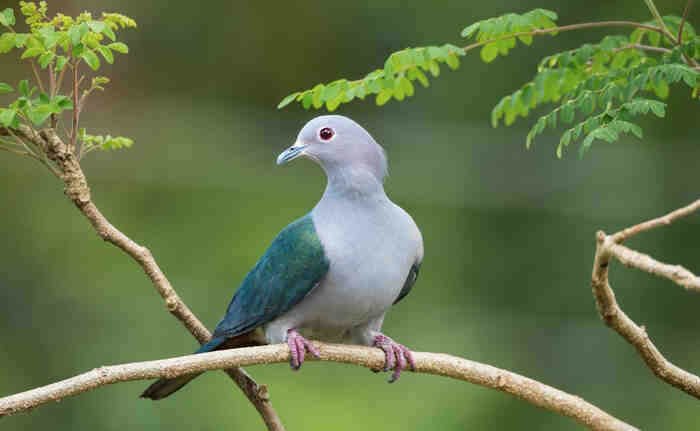Ducula aenea
IUCN
LCBasic Information
Scientific classification
- name:Ducula aenea
- Scientific Name:Green dove, big green dove, big green pigeon,Ducula aenea,Green Imperial Pigeon
- Outline:Landfowl
- Family:Columbiformes Columbidae L.Pigeon
Vital signs
- length:36-43cm
- Weight:508-600g
- lifetime:No verification information
Feature
The sound is very special, very much like the sound of human snickering
Distribution and Habitat
Distributed in Bangladesh, Bhutan, Brunei, Cambodia, China, India, Indonesia, Lao People's Democratic Republic, Malaysia, Myanmar, Philippines, Singapore, Sri Lanka, Thailand, Vietnam.
The Green Emperor Pigeon is a resident bird, inhabiting broad-leaved forests and secondary forests in plains, river valleys and hilly areas. It also appears in small patches of jungle near settlements and on banyan and olive trees.
Appearance
The green emperor dove is larger than green doves and fruit doves, and has a larger mouth with an expanded bill base. The body is usually less variegated. The head, neck and underparts are dove gray, slightly tinged with pinkish grape red, and the lower tail coverts are dark maroon. The forehead and forehead are white, and the back, shoulders, waist, tail coverts, and wing coverts are all bright metallic copper-green or dark green. The upper back and shoulders sometimes have a purple-red copper sheen, and the back and The waist sometimes also has black feather tips. The top of the head to the back of the neck, as well as the cheek and ear coverts of some individuals are brown-gray, purple-gray or brown-maroon. The tail feathers are similar in color to the back, also metallic copper-green, but lack the metallic luster and have more blue.
Iris red. The mouth is lead brown to lead black, and the ends are ivory white, sometimes stained with orange-red. The feet are dark purple-red or br
Details
Green Imperial Pigeon, also known as Green Imperial Pigeon, has 15 subspecies.

Green Imperial Pigeons often move alone or in pairs, and also in groups in winter. It often moves in the canopy, especially in the morning and evening. It often lives on the dead branches at the top of the big tree. It rarely goes to the ground, usually only when it needs to peck at the mud and sand. It flies fast and powerfully, mostly in the sky, but does not flap its wings frequently. Its call is "coo, coo, coo,...", which is relatively deep. Even if it calls nearby, it sounds like a sound coming from far away. The last sound before the end is relatively long and the sound is also very special, which is very much like the sound of human snickering.
The Green Emperor Pigeon mainly feeds on plant fruits such as figs, especially black olives, which can be swallowed whole even if they are larger than its head. It also eats insects occasionally. It often forages with other pigeons, but the species vary depending on the feeding place. For example, on trees with small fruits such as banyan trees, it is mostly with green pigeons, while on olive trees and trees with large figs, it is mostly with large pigeons such as mountain emperor pigeons.
The breeding season of the Green Emperor Pigeon is from April to July. When courting, the male bird frequently shows off to the female bird by sticking out his chest, nodding, loosening the feathers on his neck, and walking in circles. It nests on the branches of trees in the forest. The nest is mainly made of dead branches, in a shallow dish shape, relatively simple, and there is no bedding in the nest. Each nest lays 1-2 eggs. The eggs are white in color and 41-51×31-37 mm in size. The male and female birds take turns to incubate the eggs.
Listed in the Red Data Book of Endangered Animals in China: Vulnerable.
Listed in the 2012 Red List of Endangered Species of the World Conservation Union (IUCN) ver 3.1 - Least Concern (LC).
Listed in the second level of the "List of National Key Protected Wildlife in China".
Protect wildlife and eliminate game.
Maintaining ecological balance is everyone's responsibility!








